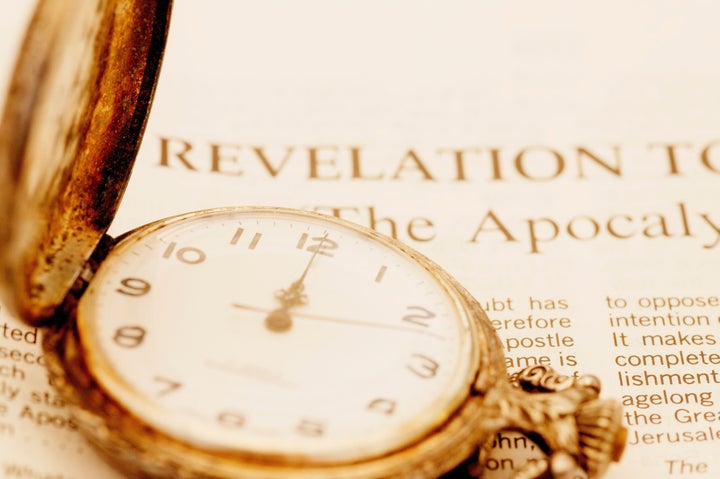
Apocalypse is always fashionable news. After all, what could be a bigger story than the end of the Earth, or at least its veneer of troublesome, hominid fuzz?
The past 12 months have seen plenty of predictions on the imminent demise of either the planet or some substantial fraction of its human inhabitants. This year, the winner in the end-times sweepstakes is a highly hyped warning from the Mayan calendar. If you believe this stuff, the world will come to an end just in time for Christmas.
I don't believe it, so I'm still getting my car smogged, and paying my 2012 estimated taxes. One reason I'm pretty sure I'll see 2013 is that the mechanism proposed for the Mayan final twitch is some sort of bonkers, massively malevolent cosmic alignment, presumably involving the center of our galaxy. Sure, the galactic center is big and brawny, but work it out: its gravitational pull on Earth is about one-thousandth that of Jupiter -- and that spotted and striped planet aligns with us all the time, provoking neither comment nor catastrophe.
In fact, predicting the end of the world, while always popular, has little precedent for success. Consider the worst disasters you can recall. The Black Plague claimed about 75 million victims during the 14th century, and in historical times we've had two world wars and the 1918 flu epidemic. All of these were tragic on a scale not seen before. But they weren't Armageddon.
Apocalypse is major theater, and in the history of this planet giant rocks from space are among the few villains up to the part. The asteroid that snuffed the dinosaurs 65 million years ago also wiped out the majority of all land dwelling species. That could happen again, and it's certainly a worthy worry. However, there's a good chance that we'll be able to deflect the next large rock targeting our planet. It's one scenario that needn't play out.
Another contender for major mishap was the time, about 700 million years ago, when naturally-induced climate change caused all the oceans -- from the poles to the equator -- to freeze over. "Snowball Earth" was a true catastrophe, although it didn't wipe out all terrestrial life.
In fact, in the last 4 billion years, nothing has managed to completely eradicate Earth's biology. Nothing. And despite the various dangers we pose to ourselves, humans aren't capable of sterilizing the planet either.
So is apocalypse merely a fantasy that will never happen? Like self-making beds, or carefree hair?
Of course not -- there will be an end to life on Earth.
Most people are aware that the Sun is slowly running out of fuel. Eventually, it will briefly swell up to dozens of times its present size, and end its life as a cooling charcoal briquette. The onset of this depressing scenario is five billion years hence. But between now and then, we will confront another dismal circumstance. As the Sun burns through its energy supply, it actually gets brighter. Indeed, over the course of the next billion years, the Sun will become about 10 percent more luminous than it is now.
Several years ago, Penn State academics James Kasting and Ken Caldeira (now at the Carnegie Institute at Stanford University) worked out some of the consequences of this slow ramping up of the Sun's output. The important points are these: The oceans, made warmer, will evaporate more quickly, injecting vast amounts of water vapor into the atmosphere. Water vapor -- in case you've forgotten -- is the most important greenhouse gas. So the result is even more warming, and yet more evaporation.
In addition, increased rainfall on a hotter world will cause faster weathering of rocks, which will send greater amounts of calcium and silicate materials into the oceans. There, small sea creatures will combine these compounds with the carbon dioxide that's dissolved in the oceans (like seltzer water) to make their protective shells. When the creatures die, their mostly calcium carbonate outerwear falls to the ocean floor. There, it piles up uselessly as biological wallboard. This mechanism slowly locks up much of the world's supply of carbon dioxide.
The net result of this little bit of global chemistry is that Earth will be a warmer planet, yes, but one with less carbon dioxide in its air. You might think that the reduced CO2 would cause enough cooling to offset the additional warming due to the Sun and all that atmospheric water vapor, but it won't. However, the reduction in CO2 will do this: It will cause nearly all the important plants in our food chain to die. For animals, that means slow starvation.
Now that's an apocalypse worthy of the name. No, it's not in the Mayan calendar, but it's something our distant descendants are guaranteed to confront.
Maybe they can put giant sunshades in space, or pull off some other technical tour de force to avoid the problem, and sidestep Armageddon. It's not impossible. But in the meantime, my advice is to forget the Mayan calendar, count on a long string of tomorrows, and get your car smogged.